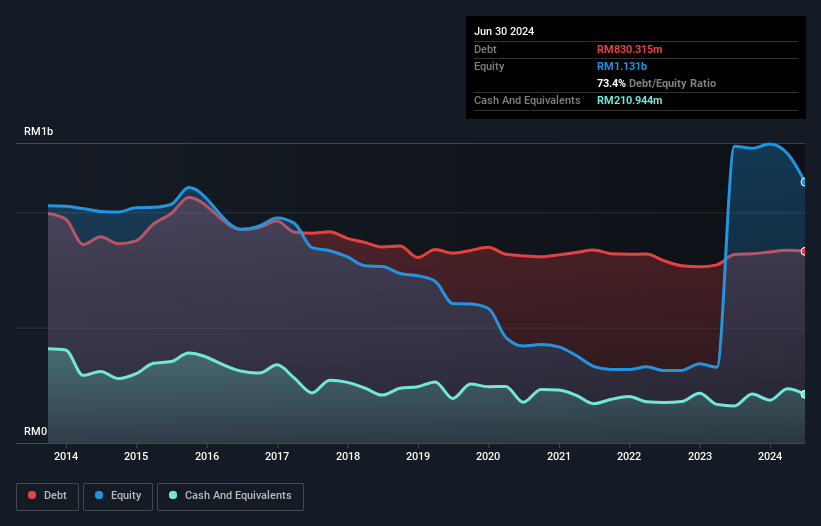- Malaysia
- /
- Industrials
- /
- KLSE:MUIIND
Is Malayan United Industries Berhad (KLSE:MUIIND) Using Too Much Debt?
Warren Buffett famously said, 'Volatility is far from synonymous with risk.' It's only natural to consider a company's balance sheet when you examine how risky it is, since debt is often involved when a business collapses. We can see that Malayan United Industries Berhad (KLSE:MUIIND) does use debt in its business. But is this debt a concern to shareholders?
Why Does Debt Bring Risk?
Debt assists a business until the business has trouble paying it off, either with new capital or with free cash flow. If things get really bad, the lenders can take control of the business. While that is not too common, we often do see indebted companies permanently diluting shareholders because lenders force them to raise capital at a distressed price. Having said that, the most common situation is where a company manages its debt reasonably well - and to its own advantage. The first step when considering a company's debt levels is to consider its cash and debt together.
See our latest analysis for Malayan United Industries Berhad
How Much Debt Does Malayan United Industries Berhad Carry?
As you can see below, Malayan United Industries Berhad had RM830.3m of debt, at June 2024, which is about the same as the year before. You can click the chart for greater detail. However, it also had RM210.9m in cash, and so its net debt is RM619.4m.

How Strong Is Malayan United Industries Berhad's Balance Sheet?
According to the last reported balance sheet, Malayan United Industries Berhad had liabilities of RM461.8m due within 12 months, and liabilities of RM951.4m due beyond 12 months. On the other hand, it had cash of RM210.9m and RM125.4m worth of receivables due within a year. So its liabilities total RM1.08b more than the combination of its cash and short-term receivables.
The deficiency here weighs heavily on the RM225.8m company itself, as if a child were struggling under the weight of an enormous back-pack full of books, his sports gear, and a trumpet. So we'd watch its balance sheet closely, without a doubt. At the end of the day, Malayan United Industries Berhad would probably need a major re-capitalization if its creditors were to demand repayment. The balance sheet is clearly the area to focus on when you are analysing debt. But you can't view debt in total isolation; since Malayan United Industries Berhad will need earnings to service that debt. So if you're keen to discover more about its earnings, it might be worth checking out this graph of its long term earnings trend.
Over 12 months, Malayan United Industries Berhad made a loss at the EBIT level, and saw its revenue drop to RM396m, which is a fall of 18%. We would much prefer see growth.
Caveat Emptor
Not only did Malayan United Industries Berhad's revenue slip over the last twelve months, but it also produced negative earnings before interest and tax (EBIT). Indeed, it lost a very considerable RM221m at the EBIT level. Combining this information with the significant liabilities we already touched on makes us very hesitant about this stock, to say the least. That said, it is possible that the company will turn its fortunes around. But we think that is unlikely, given it is low on liquid assets, and burned through RM26m in the last year. So we consider this a high risk stock and we wouldn't be at all surprised if the company asks shareholders for money before long. When analysing debt levels, the balance sheet is the obvious place to start. However, not all investment risk resides within the balance sheet - far from it. To that end, you should learn about the 2 warning signs we've spotted with Malayan United Industries Berhad (including 1 which is a bit unpleasant) .
At the end of the day, it's often better to focus on companies that are free from net debt. You can access our special list of such companies (all with a track record of profit growth). It's free.
New: Manage All Your Stock Portfolios in One Place
We've created the ultimate portfolio companion for stock investors, and it's free.
• Connect an unlimited number of Portfolios and see your total in one currency
• Be alerted to new Warning Signs or Risks via email or mobile
• Track the Fair Value of your stocks
Have feedback on this article? Concerned about the content? Get in touch with us directly. Alternatively, email editorial-team (at) simplywallst.com.
This article by Simply Wall St is general in nature. We provide commentary based on historical data and analyst forecasts only using an unbiased methodology and our articles are not intended to be financial advice. It does not constitute a recommendation to buy or sell any stock, and does not take account of your objectives, or your financial situation. We aim to bring you long-term focused analysis driven by fundamental data. Note that our analysis may not factor in the latest price-sensitive company announcements or qualitative material. Simply Wall St has no position in any stocks mentioned.
About KLSE:MUIIND
Malayan United Industries Berhad
An investment holding company, primarily engages in the retailing, hotel, property, food, fast food chain, and financial service businesses in Malaysia, the Asia-Pacific, Australia, North America, and the United Kingdom.
Mediocre balance sheet and slightly overvalued.
Market Insights
Community Narratives


Recently Updated Narratives


Q3 Outlook modestly optimistic


Alphabet: The Under-appreciated Compounder Hiding in Plain Sight


MINISO's fair value is projected at 26.69 with an anticipated PE ratio shift of 20x
Popular Narratives


The company that turned a verb into a global necessity and basically runs the modern internet, digital ads, smartphones, maps, and AI.


MicroVision will explode future revenue by 380.37% with a vision towards success



